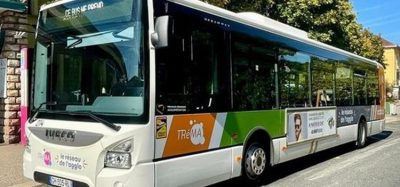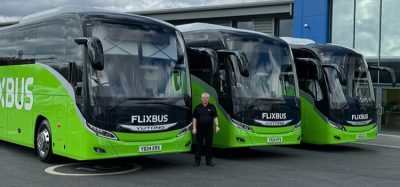Could entertainment on public transport become a big revenue generator in the future?
- Like
- Digg
- Del
- Tumblr
- VKontakte
- Buffer
- Love This
- Odnoklassniki
- Meneame
- Blogger
- Amazon
- Yahoo Mail
- Gmail
- AOL
- Newsvine
- HackerNews
- Evernote
- MySpace
- Mail.ru
- Viadeo
- Line
- Comments
- Yummly
- SMS
- Viber
- Telegram
- Subscribe
- Skype
- Facebook Messenger
- Kakao
- LiveJournal
- Yammer
- Edgar
- Fintel
- Mix
- Instapaper
- Copy Link
Posted: 8 September 2017 | Glyn Pierce-Jones (Group Managing Director at Trolex Group Ltd) | No comments yet
Glyn Pierce-Jones, Group Managing Director at Trolex Group Ltd argues that with innovative passenger-focussed transportation services like Uber generating 6.5 billion dollars in 2016 and MaaS becoming the ‘Netflix of Transportation’ isn’t it time that more operators start to invest more in to technology and entertainment to improve passenger experience?


From horse-drawn cart to high-speed rail transit, public transport has evolved significantly. Passengers now have a variety of transportation options, from cabs that can be acquired in minutes via mobile apps, to booking flights on the same day.
But while getting from A to B has always been the principal concern, many transport operators have failed to address the customer experience. As transport continues to evolve, it’s no longer just about providing the basic, minimum ‘service’, but providing passengers with value for their money and ensuring they have a pleasant experience.
Transport providers, therefore, need to be thinking: ‘How can we enhance the on-board experience and provide customers with what they need?’
The answer? On-demand transportation solutions, services, and on-board entertainment.
Let’s take Uber for example. Uber rapidly dominated the on-demand mobility space in the transportation market by realising that customers wanted an on-demand transportation solution. Uber quickly developed its ride-sharing app, marketed it, and the rest is history. As a result, Uber has had – and continues to have – commercial success. And, in 2016 alone, Uber generated an incredible $6.5 billion dollars – just to help people to get around!
But that’s just the tip of the iceberg. Uber represents a small piece of the wider on-demand transportation picture. What if there was a service that allowed its customers to get wherever they wanted, using the methods of transport most applicable to them – all for a monthly fee?
Well, have you heard about Mobility-as-a-Service?
Mobility-as-a-Service (MaaS) – set to be a trillion-dollar market by 2030 according to an estimate by ABI Research – represents the future of intelligent transportation. Dubbed as the ‘Netflix of Transportation’, MaaS is built on the idea of providing customers, who pay a monthly subscription fee, with unlimited access to any transportation modes to get from A to B. Customers can fire up an app, select the modes of transport they would like to use, and pay for all of those transport options directly from the app. In addition, customers can tailor their transport preferences, selecting the modes of transport most appropriate for them.
One of the fathers of the MaaS concept, Sampo Hietanen, has used it to build an on-demand transportation start-up called MaaS Global. Mass Global has developed its own app called Whim, which provides its customers – on a subscription basis – unlimited access to taxis, public transport, car rental and bikes, delivering a truly on-demand and diverse transportation solution.
What about on-board services and on-board digital entertainment?
The next aspects that transport providers need to address are on-board services and entertainment. On-board digital technology services and entertainment can transform the passenger experience, open up new channels for commercial advertising partnerships, and generate significant revenue. Some train operators have already incorporated these solutions into their services, delivering passengers everything they need.
On-board services include:
- Luggage alerts: passengers can tag their luggage with a GPS device that informs them, via an app, where their luggage is at all times, giving them peace of mind
- Real-time information updates: transport operators can keep passengers up-to-date at all times with the latest developments, including departure and arrival times, weather, current congestion (if any) and connections to other stations
- Seat reservation: rather than risk the possibility of standing, passengers can reserve their seats directly from a mobile app, choosing the exact seat they prefer
- In-seat ordering: once on the train, passengers can order food and drinks directly to their seat from a mobile app and pay for those items all in one go.
The on-board entertainment solution is equally diverse, including:
- Streamed content: passengers can stream content directly to their device, whether it’s a laptop, mobile phone or tablet, enabling them to watch the latest movies, TV shows, sports programmes, catch up with the news, check destination information, play games, read magazines and much more. The content can then be customised to suit the passenger need and demographic
- High-speed Wi-Fi: having internet connectivity, whether that’s a 3G, 4G, or 5G network, is something we have all come to expect whilst venturing around any major city and its outskirts. If we can get Wi-Fi in McDonalds, why can’t we get it on a bus or train? In the modern era, commuters are constantly on mobile phones, laptops or tablet devices, ensuring they are up-to-date with everything. On that basis, it’s a great opportunity to provide passengers with the connectivity they need to do more. Having a dedicated, high-speed Wi-Fi network on-board adds the kind of value customers will come to love transport operators for.


Remember, it’s all about the customer
At the end of the day, it all depends on what the customer wants and needs. For example, on shorter commutes, passengers will be less likely to watch movies – maybe TV shows at a stretch. But including Wi-Fi, on-board entertainment and content features such as news updates, location and travel information that can be streamed directly to their devices is valuable. Also, having on-board features such as plug sockets and USB ports enables passengers to charge their devices. A small change, but it shows the passenger that the provider has taken into account their every need.
For longer commutes, digital on-board services that provide movies and other long-form content would go down tremendously well. But before providers invest heavily, it’s vital to assess the current customer base via surveys and test initiatives to determine how receptive they will be towards these projects.
Remember, it’s all about the customer – and the inclusion of on-demand and digital services across all transport operations will not only provide your customers with a better experience, but also enable you to attract more business and generate more revenue in the future.
Related topics
Business Models, Fleet Management & Maintenance, Multimodality, Passenger Experience, Ticketing & Payments, Transport Governance & Policy
Related organisations
Trolex Group Ltd, Uber








